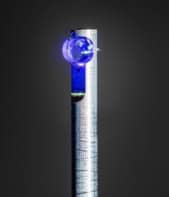
By Hamish Johnston
I have just updated the “Featured Journal” slot on physicsworld.com to include a paper published today that presents a “feasible” recipe for creating a metamaterial that could completely cloak an object from sound — at least in two dimensions.
Instead of absorbing and/or reflecting sound like traditional acoustic insulation, an acoustic cloak would guide sound waves around an object, much like water flowing around a stone in the middle of a stream. This analogy makes it easy to see why those charged with hiding submarines from sonar would like to get their hands on such a material.
But don’t expect to be able to cover the walls of your bedroom with the stuff and finally get a good night’s sleep, because the authors haven’t actually made the material yet (although if your neighbour’s microwave oven is keeping you awake, physicists have made a microwave cloak).
The paper is by Daniel Torrent and José Sánchez-Dehesa of the Polytechnic University of Valencia, Spain. I spoke with Sánchez-Dehesa earlier this year when I wrote a news story about a paper they published in February. This earlier work suggested that an acoustic cloak could be made by surrounding an object with an array of cylindrical rods. If the rods had the right elastic properties and their radii and spacing were varied in a specific way, silence would reign.

However, it looks like they have decided that this earlier design cannot be built using real materials. Now, they have refined their design to a multilayered composite of two different “sonic crystals” — with each crystal being a lattice of cylindrical rods.
Torrent and José Sánchez-Dehesa have calculated that about 200 metamaterial layers would be required to cloak an object over a wide range of acoustic frequencies — although it’s not clear from the paper how thick this would be if real materials were used.
Both papers are published in the New Journal of Physics, which will be putting out a special issue on “Cloaking and Transformation Optics” later this year.



